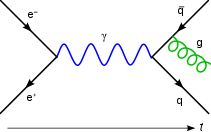In quantum field theory the vacuum expectation value (also called condensate or simply VEV) of an operator is its average or expectation value in the vacuum. The vacuum expectation value of an operator O is usually denoted by One of the most widely used examples of an observable physical effect that results from the vacuum expectation value of an operator is the Casimir effect.
This concept is important for working with correlation functions in quantum field theory. It is also important in spontaneous symmetry breaking. Examples are:
- The Higgs field has a vacuum expectation value of 246 GeV. This nonzero value underlies the Higgs mechanism of the Standard Model. This value is given by , where MW is the mass of the W Boson, the reduced Fermi constant, and g the weak isospin coupling, in natural units. It is also near the limit of the most massive nuclei, at v = 264.3 Da.
- The chiral condensate in quantum chromodynamics, about a factor of a thousand smaller than the above, gives a large effective mass to quarks, and distinguishes between phases of quark matter. This underlies the bulk of the mass of most hadrons.
- The gluon condensate in quantum chromodynamics may also be partly responsible for masses of hadrons.
The observed Lorentz invariance of space-time allows only the formation of condensates which are Lorentz scalars and have vanishing charge. Thus fermion condensates must be of the form , where ψ is the fermion field. Similarly a tensor field, Gμν, can only have a scalar expectation value such as .
In some vacua of string theory, however, non-scalar condensates are found. If these describe our universe, then Lorentz symmetry violation may be observable.
See also
- Correlation function (quantum field theory)
- Dark energy
- Spontaneous symmetry breaking
- Vacuum energy
- Wightman axioms
References
- Amsler, C.; et al. (2008). "Review of Particle Physics⁎". Physics Letters B. 667 (1–5): 1–6. Bibcode:2008PhLB..667....1A. doi:10.1016/j.physletb.2008.07.018. hdl:1854/LU-685594. S2CID 227119789. Archived from the original on 2012-07-12. Retrieved 2015-09-04.
External links
 Quotations related to Vacuum expectation value at Wikiquote
Quotations related to Vacuum expectation value at Wikiquote
This quantum mechanics-related article is a stub. You can help Misplaced Pages by expanding it. |

 One of the most widely used examples of an observable physical effect that results from the vacuum expectation value of an operator is the
One of the most widely used examples of an observable physical effect that results from the vacuum expectation value of an operator is the  , where MW is the mass of the W Boson,
, where MW is the mass of the W Boson,  the reduced
the reduced  , where ψ is the fermion field. Similarly a
, where ψ is the fermion field. Similarly a  .
.